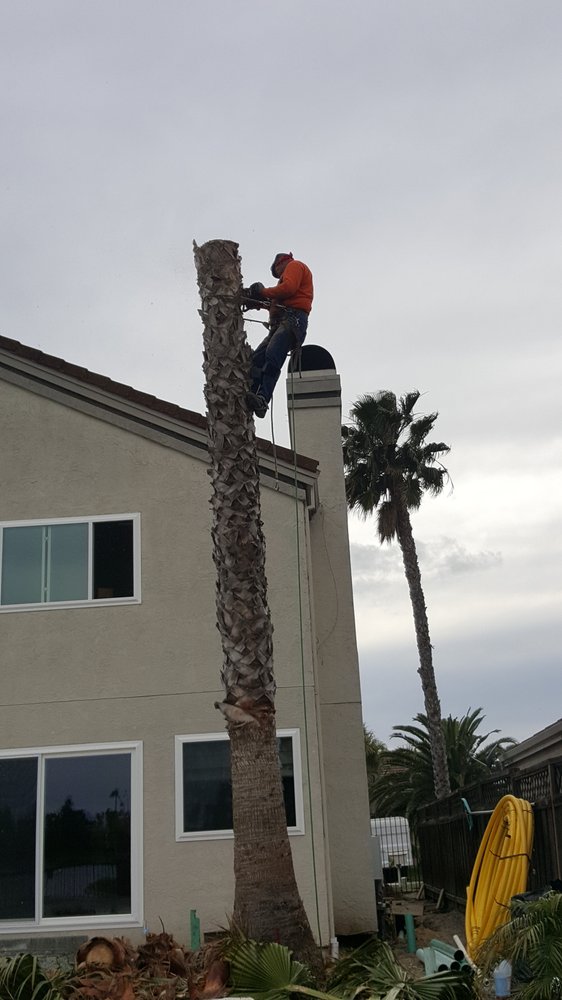Trimming palm trees requires a systematic approach to ensure the tree’s health and aesthetics are maintained. Follow these steps for proper palm tree trimming:
1. Assess the palm tree: Before you begin trimming, take a close look at the palm tree and identify the areas that need attention. Focus on removing dead or damaged fronds, as well as any crossing or rubbing branches.
2. Start from the bottom: Begin trimming from the lower part of the palm tree and work your way up. This allows you to maintain balance and control throughout the trimming process.
3. Remove dead fronds: Dead fronds should be removed first. Cut them as close to the trunk as possible without damaging the tree. Be cautious not to remove green fronds, as they are essential for the tree’s growth.
4. Trim green fronds sparingly: While it’s important to remove dead fronds, it’s equally important not to over-prune green fronds. Only trim the green fronds that are hanging too low or are obstructing the tree’s appearance.
5. Avoid trimming near the bud: The bud, also known as the heart of the palm tree, is located at the top center of the tree. Avoid trimming near the bud, as it can cause irreversible damage to the tree.
6. Clean up debris: As you trim, collect the cut fronds and branches to prevent them from becoming a safety hazard or breeding ground for pests. Dispose of the debris properly or consider using them for mulch.
Remember, it’s crucial to space out palm tree trimming sessions to avoid excessive stress on the tree. Aim to trim your palm tree every 1-2 years, depending on its growth rate and overall health.
DIY palm tree trimming tips and precautions
While palm tree trimming can help maintain the health and appearance of your trees, there are instances when removal becomes necessary. Here are some considerations to keep in mind when contemplating palm tree removal:
1. Safety concerns: If your palm tree poses a safety hazard due to structural issues, disease, or proximity to power lines or structures, removal may be the safest option.
2. Diseased or infested trees: Palm trees that are severely diseased or infested with pests may not recover even with proper care. Removing the tree can prevent the spread of diseases or pests to other healthy trees in your vicinity.
3. Landscape changes: If you’re planning to redesign your landscape and the palm tree no longer fits the aesthetic or purpose, removal may be necessary. Consider alternative tree options that better suit your new design.
4. Root system damage: In some cases, a palm tree’s root system can cause damage to surrounding structures, sidewalks, or plumbing. If the root system is causing significant problems, removal might be the best solution.
When considering palm tree removal, it’s advisable to consult with a professional arborist who can assess the tree’s condition and provide expert advice.
Palm tree trimming cost and budgeting
While DIY palm tree trimming can be a rewarding experience, it’s not always feasible or safe for every situation. Hiring a professional palm tree trimming service comes with several benefits:
1. Safety: Professional arborists have the expertise and experience to safely handle palm tree trimming and removal, minimizing the risk of accidents or injuries.
2. Efficiency and precision: Arborists are trained to assess the condition of palm trees and determine the best trimming or removal techniques. They have the right tools and equipment to get the job done efficiently and with precision.
3. Insurance coverage: Professional arborists are typically insured, providing you with peace of mind in case of any property damage or accidents during the trimming or removal process.
4. Knowledge and advice: Arborists can provide valuable insights on palm tree care, maintenance, and disease prevention. They can also offer guidance on selecting the right palm tree species for your landscape.
When hiring a professional palm tree trimming service, ensure they are licensed, insured, and have positive reviews from previous clients.
Palm tree maintenance after trimming or removal
If you decide to tackle palm tree trimming on your own, here are some tips and precautions to keep in mind:
1. Educate yourself: Before you start trimming, research the specific palm tree species you have and understand its growth patterns, trimming requirements, and potential risks.
2. Safety first: Always prioritize your safety. Wear protective gear, ensure your tools are in good condition, and be mindful of your surroundings.
3. Avoid excessive pruning: Over-pruning can stress the palm tree and hinder its growth. Only remove what is necessary for safety and aesthetics.
4. Don’t top your palm tree: Topping, the practice of removing the entire crown of a palm tree, is highly discouraged. It can lead to irreversible damage and compromise the tree’s health.
5. Disinfect your tools: Clean and disinfect your tools before and after trimming to prevent the spread of diseases between trees.
Remember, if you have any doubts or concerns about palm tree trimming, it’s best to consult with a professional arborist.
Conclusion: Keeping your palm trees healthy and beautiful
The cost of palm tree trimming can vary depending on various factors, such as the size of the tree, its location, and the extent of trimming required. Here are some cost considerations and budgeting tips:
1. Tree size: Larger palm trees may require more time, effort, and equipment, which can increase the cost of trimming.
2. Accessibility: If your palm tree is in a hard-to-reach area or requires special equipment for trimming, it may incur additional costs.
3. Additional services: Some palm tree trimming services may offer additional services such as debris removal or stump grinding, which can increase the overall cost.
4. Regular maintenance: Investing in regular palm tree maintenance can reduce the need for extensive trimming or removal in the future, potentially saving you money in the long run.
To budget for palm tree trimming, get multiple quotes from reputable arborists in your area. Compare the prices and services offered to make an informed decision.


